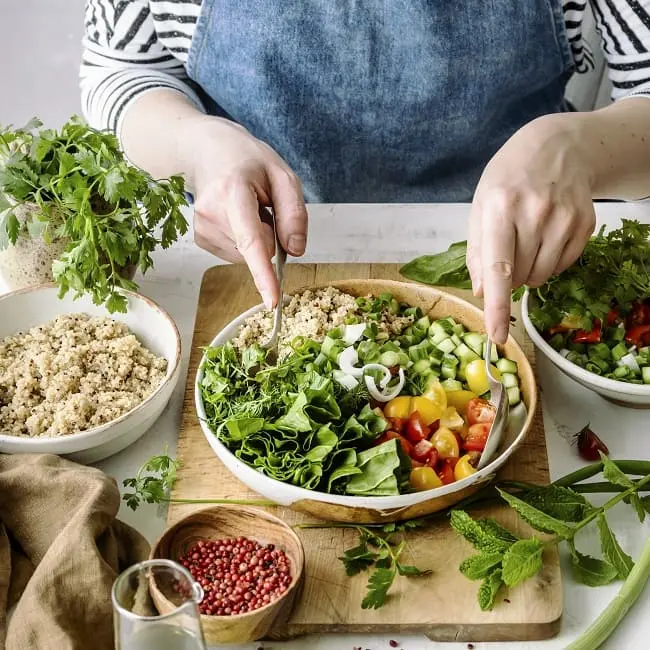Gluten, the protein found in wheat, barley and rye, can cause digestive problems, fatigue, headaches and allergies in some people. These people must then adopt a gluten-free diet, excluding all foods that contain or may contain this protein.
But what is a gluten-free diet? Which foods should be preferred and which should be avoided? What are the benefits and risks of such a diet?
In this article, we tell you all you need to know about the gluten-free diet: its foundations, basic principles, potential benefits and limitations. We’ll also give you a few tips on how to easily integrate a gluten-free diet into your daily routine, without giving up or complicating your life.

Why eat gluten-free?
Definition: what is gluten?
Gluten is a protein found in cereals such as wheat, barley and rye. It acts as a binding agent, giving food products made from these cereals their elasticity and structure.
This protein is divided into two main fractions: gliadin and glutenin. Gliadin is the protein that triggers an immune response in people with gluten intolerance.
Why a gluten-free diet?
Gluten should be avoided in three main cases: celiac disease, non-celiac gluten sensitivity and wheat allergy. Celiac disease is an autoimmune disorder that causes inflammation and destruction of the intestinal mucosa in the presence of gluten. It can cause both digestive and extra-digestive symptoms, including fatigue, anemia, osteoporosis and depression.
Non-celiac gluten sensitivity manifests itself with symptoms similar to those of celiac disease, but without intestinal lesions. It may be linked to poor digestion of gluten or a reaction to FODMAPs, fermentable carbohydrates found in certain cereals.
Wheat allergy is an immediate allergic reaction to certain components of wheat, including gluten. It can lead to symptoms affecting the skin and respiratory tract, and even to anaphylactic reactions.
In all these cases, the adoption of a strict gluten-free diet is the only proven effective treatment. This involves completely eliminating gluten-containing products from the diet. This diet helps relieve symptoms, prevent complications and improve quality of life for sufferers.
How to start a gluten-free diet?
What are the alternatives to gluten?
The first step in adopting a gluten-free diet is to identify and eliminate gluten-containing products from your diet. The main foods to avoid are wheat, rye, barley, spelt, kamut and oats, as well as their derivatives such as bread, pasta, cookies, cakes, cereals, semolina and flour.
Beware also of processed products that may contain gluten as an additive, thickener or binder, such as sauces, soups, ready-made meals, cold meats, cheeses and beers. It’s essential to read product labels for the words “gluten-free” or the crossed-out wheat ear symbol.
Fortunately, there are many gluten-free alternatives, including rice, corn, buckwheat, quinoa, millet, teff, sorghum and amaranth. These cereals can be used in various forms, such as grains, flakes, flour or starch. Potato, cassava, soy, chestnut, coconut and banana flours and starches also offer excellent gluten-free options.
These alternatives can be used to prepare a variety of delicious recipes such as pancakes, cakes, muffins and breads. What’s more, many ready-to-use gluten-free products are available in specialist store shelves or on dedicated websites.
How can I tell if food is gluten-free?
Knowing how to read food labels is essential for those following a gluten-free diet, as gluten can hide under different names or be included in unexpected products. So it’s important to be vigilant and aware of the different names for gluten.
Here are a few terms to watch out for, which may indicate the presence of gluten in a product:
- Vegetable or hydrolyzed proteins;
- Starch or modified starch (unless otherwise indicated);
- Malt or maltodextrin (unless otherwise indicated);
- Emulsifiers or stabilizers (E400 to E495);
- Glucose or maltose syrup (unless otherwise indicated);
- Yeast or malt extract;
- Dextrin or dextrose (unless otherwise indicated).
Since 2005, European regulations have required manufacturers to clearly indicate the presence of gluten in their products. However, it’s important to remain vigilant in the face of possible cross-contamination during manufacture, transport or storage.
To be on the safe side, choose products certified gluten-free by independent bodies, such as AFDIAG in France or the Association Suisse Romande de la Maladie Cœliaque in Switzerland.
7 tips for gluten-free cooking at home
Gluten-free cooking is easy if you follow a few basic rules. Here are a few tips for healthy, tasty gluten-free meals:
- Choose foods that are naturally gluten-free, such as fruits, vegetables, meats, fish, eggs, legumes, oilseeds and dairy products;
- Vary the sources of gluten-free cereals, such as rice, corn, buckwheat and quinoa, and combine them with legumes for an adequate intake of complex carbohydrates and fiber;
- Use gluten-free flours or starches in your preparations and experiment by combining them to improve texture and taste, for example by mixing rice, corn, buckwheat and chestnut flours to obtain a gluten-free bread;
- Incorporate leavening agents such as bicarbonate, cider vinegar or lemon juice to aerate your gluten-free preparations;
- Enrich your recipes with ingredients such as dried fruit, seeds, chocolate, applesauce or mashed bananas to add softness, crunch or fondant;
- Adapt cooking times and temperatures, which are often faster and lower for gluten-free preparations;
- Avoid cross-contamination by using dedicated utensils and workspaces for gluten-free foods, and separating them from gluten-containing foods in refrigerators and cupboards.

Daily life on a gluten-free diet
Gluten-free diet: how to manage meals away from home?
Adopting a gluten-free diet doesn’t have to limit your social activities, be they meals with family, friends or in restaurants. It’s perfectly possible to enjoy these moments by taking a few precautions to avoid gluten and cross-contamination.
Here are some effective tips for eating out:
- Inform your hosts or restaurants of your gluten-free diet, specifying what you can and can’t eat. Offer to bring gluten-free substitutes or help prepare meals;
- Opt for simple, natural dishes, such as grilled meats, salads, vegetables and fruit. Avoid dishes containing sauces, breadcrumbs, marinades, spices or condiments that may contain gluten;
- Communicate clearly with the waiter or chef about the gluten-free options available and make sure they understand the need to avoid gluten for your health;
- Always carry gluten-free snacks (cereal bars, dried fruit, cookies, etc.) to deal with the unexpected;
- Use dedicated websites or apps to find gluten-free restaurants, stores or hotels, whether close to home or on vacation.
How to avoid gluten traces and cross-contamination?
Cross-contamination occurs when a gluten-free food comes into contact with a food containing gluten, and can occur at any stage of the food chain. For people suffering from gluten intolerance, even a small amount of gluten can have serious repercussions.
Here’s how to avoid cross-contamination:
- Preferably buy certified gluten-free products, identified by the words “gluten-free” or the “crossed-out ear of wheat” logo, guaranteeing their compliance with strict standards;
- Always read product labels for indications such as “traces of gluten” or “may contain gluten”, and avoid them if necessary;
- Dedicate utensils and kitchen areas to gluten-free, and ensure that work surfaces are clean before and after use;
- Separate gluten-free foods from other foods in the fridge, freezer and cupboards, using airtight containers;
- Avoid sharing condiments with people who eat gluten, and always use clean utensils to remove them.
How to adopt a gluten-free diet and avoid deficiencies?
A well-balanced gluten-free diet can meet all nutritional needs. However, some people may have specific needs or deficiencies due to celiac disease or gluten sensitivity.
Tips for adapting your diet to your needs:
- Eat foods rich in iron, calcium, vitamin D, vitamin B12 and folic acid to make up for any deficiencies. These nutrients are found in meat, fish, eggs, legumes, dried fruit, dairy products, fruit and vegetables;
- Choose gluten-free wholegrain or semi-complete cereals, which are richer in fiber, vitamins and minerals than their refined equivalents. Include rice, corn, buckwheat, quinoa and millet in your diet;
- Limit consumption of industrial gluten-free products, which are often rich in sugars, fats and additives, and low in nutrients. Instead, opt for natural or homemade products;
- Include probiotics and prebiotics in your diet to promote intestinal health and boost your immune system. Probiotics are found in yogurts, cheeses, kefirs and kombuchas, while prebiotics are found in bananas, artichokes, asparagus and onions;
- Consult a doctor or nutritionist to assess your specific needs, and consider taking supplements if necessary.
As we have seen, adopting a gluten-free diet is essential for people suffering from celiac disease, non-celiac gluten sensitivity or wheat allergy. This diet plays a key role in alleviating symptoms, preventing future complications and improving overall quality of life. However, sticking to it on a daily basis can be a real challenge.
To do so, you need to identify foods to avoid as well as gluten-free alternatives, master food label reading, prepare gluten-free meals at home, know how to manage meals out, avoid cross-contamination and adapt your diet to your specific nutritional needs.
It may seem complex at first, but with organization, a little creativity and a good support network, it’s entirely possible to lead a gluten-free life that’s both healthy and tasty. You’ll quickly notice the benefits to your physical and mental well-being.
So why wait? Adopt a gluten-free lifestyle today!
- Discover also
- How to describe the umami flavour?
